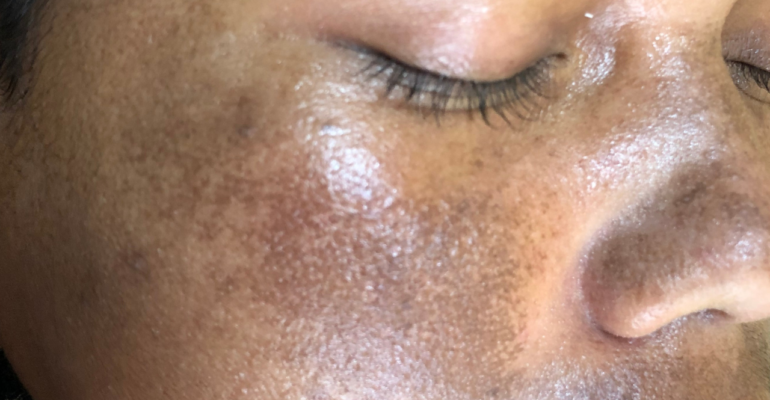Melasma: Causes, Triggers, and Treatment
April 22, 2025 2025-04-23 9:00Melasma: Causes, Triggers, and Treatment
As an Amazon associate, Dermatocare earns from valid purchase made by clicking on the affiliate links in this blog.

Melasma: Causes, Triggers, and Treatment
Melasma is a common pigmentary disorder that causes brown, gray-brown patches on the face, particularly on the cheeks, forehead, nose, upper lip, and jawline. Often dubbed the “mask of pregnancy,” melasma predominantly affects women in their 20s to 50s, especially those with Fitzpatrick skin types III–VI.
Although benign, melasma can significantly impact self-esteem and quality of life. Understanding its complex causes and evidence-based treatment options is essential for successful management.
Why Does Melasma Occur?
Melasma results from an overproduction of melanin by melanocytes (pigment cells), triggered by multiple internal and external factors. These include:
1. Hormonal Triggers
- Pregnancy (chloasma)
- Oral contraceptive pills
- Hormone replacement therapy These increase melanocyte activity, especially in estrogen-sensitive skin.
2. Sun and UV Exposure
- UV radiation stimulates melanogenesis and worsens existing pigmentation.
- Visible light also contributes to pigmentation, especially in darker skin tones.
3. Heat and Infrared Radiation
- Repeated exposure to heat (cooking, steam, saunas) can trigger melanocyte activation.
4. Genetics
- Strong familial tendency—more common in individuals with a family history.
5. Cosmetic Triggers
- Harsh scrubs, facials, and certain skin-lightening products can cause irritation and post-inflammatory pigmentation, mimicking or worsening melasma.
- Overuse of steroid cream is the most common cause of melasma in India
Types of Melasma Based on Depth
Determining the depth of pigmentation helps guide treatment:
| Type | Description | Woods Lamp Findings | Treatment Response |
|---|---|---|---|
| Epidermal | Pigment in superficial layers | Enhanced under UV light | Best response |
| Dermal | Pigment in deeper layers | No enhancement | Slower response |
| Mixed | Both epidermal & dermal | Partial enhancement | Variable response |
| Indeterminate | Cannot be classified | Often in darker skin | Needs careful evaluation |
Melasma vs. Other Pigmentation Conditions
| Condition | Features | Difference from Melasma |
|---|---|---|
| PIH (Post-Inflammatory Hyperpigmentation) | Follows acne, burns, or eczema | Localized, often resolves faster |
| Freckles/Lentigines | Small, discrete spots | Not hormonally influenced |
| Pigmented contact dermatitis | Pigmentation from cosmetics/fragrances | Usually itchy or scaly |
| Lichen planus pigmentosus | Slate gray pigmentation | Often on temples and neck |
How to Manage Melasma?
1. Sun Protection: The Cornerstone
- Broad-spectrum sunscreen (SPF 50+) with visible light protection (iron oxide-based).
- Reapply every 2–3 hours.
- Physical barriers: Hats, umbrellas, sunglasses.
2. Topical Treatments
First-Line Agents
- Hydroquinone (2–4%) – Gold standard; used in short cycles.
- Azelaic acid (15–20%) – Anti-inflammatory and safe in pregnancy.
- Kojic acid, arbutin, licorice extract – Natural tyrosinase inhibitors.
- Niacinamide (5%) – Reduces melanin transfer, enhances barrier.
Second-Line Agents
- Retinoids (Tretinoin, Adapalene) – Stimulate cell turnover; avoid in pregnancy.
- Tranexamic acid (topical/oral) – Reduces melanocyte activity via plasmin inhibition.
3. Oral Supplements
- Oral tranexamic acid (250 mg twice daily) under supervision – shows significant improvement in resistant cases.
- Antioxidants: Polypodium leucotomos, Vitamin C, Glutathione – adjunctive benefits.
4. In-Clinic Procedures
- Chemical peels: Glycolic, salicylic, mandelic acid – best for epidermal melasma.
- Laser toning (Q-switched Nd:YAG) – Use cautiously; risk of rebound in darker skin types.
- Microneedling with tranexamic acid – Emerging therapy with good tolerability.
What Not to Do in Melasma
- Avoid DIY remedies like lemon, bleach, or raw turmeric—they irritate and worsen pigmentation.
- Do not over-exfoliate or use harsh scrubs.
- Avoid over-the-counter steroid creams, which can cause steroid-induced rosacea and worsen pigmentation.
How Long Does It Take to Treat Melasma?
Melasma is chronic and relapsing, often requiring 3–6 months for visible improvement and long-term maintenance. Patient compliance, sun protection, and dermatologist supervision are critical to success.
Conclusion
Melasma is a stubborn pigmentary condition that demands a personalized, multi-pronged approach. Early diagnosis, expert-guided treatment, and diligent photoprotection are essential to minimize recurrences and maintain results.
KINDLY NOTE: At Dermatocare, we offer skincare regimes and recommendations for mild cases of melasma. If you have previously used treatments from a dermatologist or strong skin-lightening agents, we advise consulting with a dermatologist and staying under their continuous supervision for the best results.
ROUTINE FINDER
Get free dermatologist-recommended regime by choosing your skin or concerns.

FACE

HAIRS

CHILD

BODY




